Abstract
Characterization of the temporal evolution of resting segmental function and inotropic reserve after coronary occlusion may be important in evaluating attempts to salvage ischemic but non-necrotic myocardium. Accordingly, we chronically implanted up to six pairs of pulse-transit piezoelectric crystals in the left ventricular myocardium of dogs to measure segmental wall thickness. Segments were separated into groups according to the loss of net systolic thickening (NET) at 5 min postocclusion of the left anterior descending coronary artery in awake, unsedated dogs. Group 1 included segments with NET values of 67--100+ (percent control); group 2 between 67 and 0; and group 3 less than 0 (paradoxical motion). 5 min after coronary occlusion, group 1 NET was 92 +/- 5% (SEM) although significant decreases occurred in NET in group 2 (36 +/- 4%) and group 3 segments (-33 +/- 5%). Between 5 min and 24 h after coronary occlusion, no further significant changes occurred in NET in groups 1, 2, and 3 crystals. Some segments underwent further functional deterioration between 24 h and 1 wk after left anterior descending coronary artery occlusion, although no overall change occurred in segments with mild to moderate ischemic dysfunction. Segments with NET less than 0 at 24 h, on the other hand, exhibited a reduction in aneurysmal bulging between 24 h and 1 wk from -41 +/- 10 to -23 +/- 11% (n = 12, P = 0.02). Inotropic reserve was assessed with postextrasystolic potentiation (PESP) in 14 dogs, and with infusions of dopamine (11 dogs), and isoproterenol (13 dogs). PESP was the most potent intervention and produced a significant augmentation in NET in group 2 crystals at 1, 2, 4, 6,8, and 24 h after coronary occlusion but only at 1 and 2 h in NET in group 3 crystals. Thus, following experimental coronary occlusion, the evolution of ischemic segmental dysfunction is dynamic and variable. A significant degree of inotropic reserve, as assessed by PESP, dopamine, and isoproterenol, exists in segments with moderate ischemic dysfunction for 24 h but for only 2 h after coronary occlusion in those segments with the most severe ischemic dysfunction. In addition, at least some segmental sites with mild to moderate ischemic dysfunction at 24 h deteriorate further between 24 h and 1 wk after experimental coronary occlusion.
Full text
PDF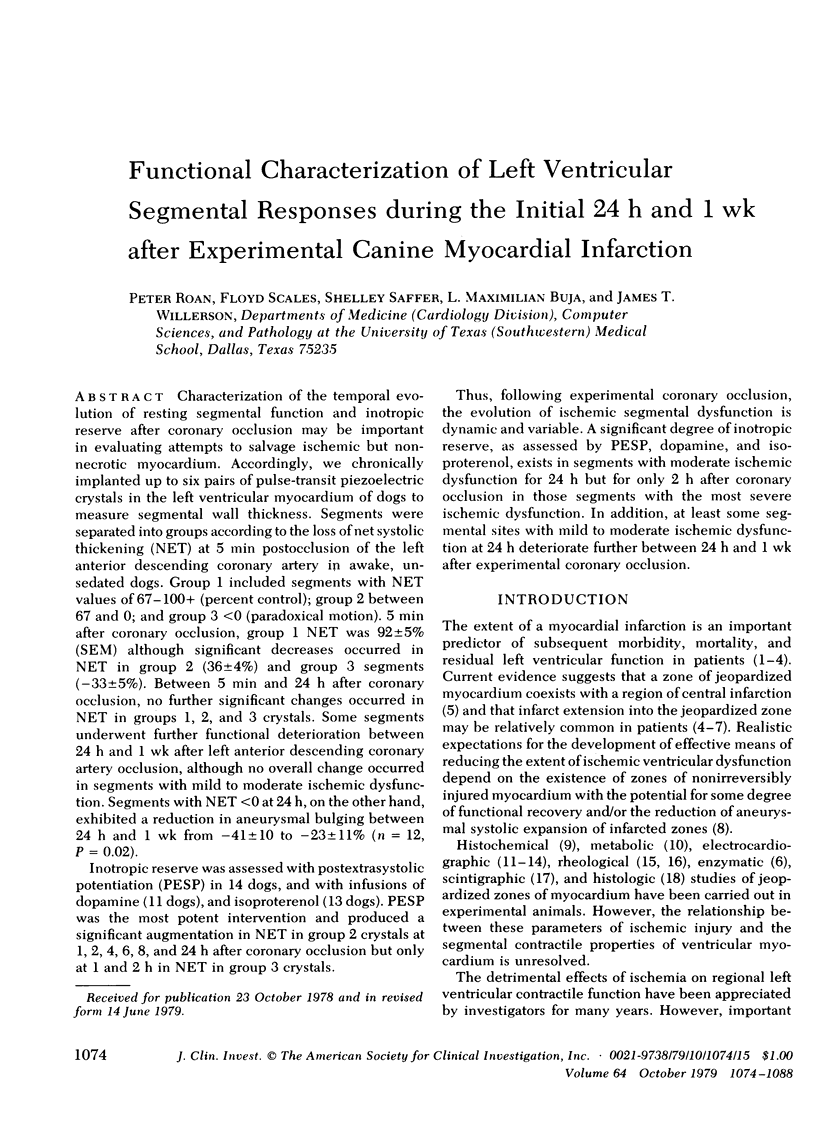
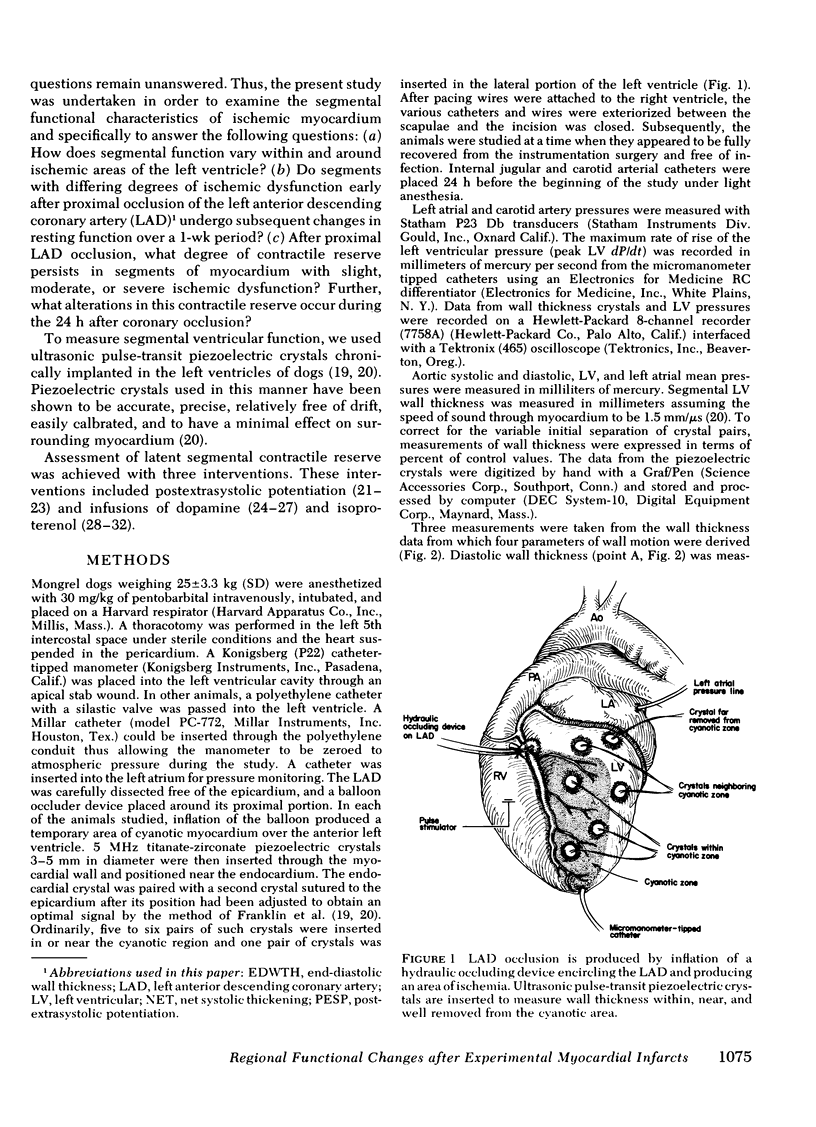
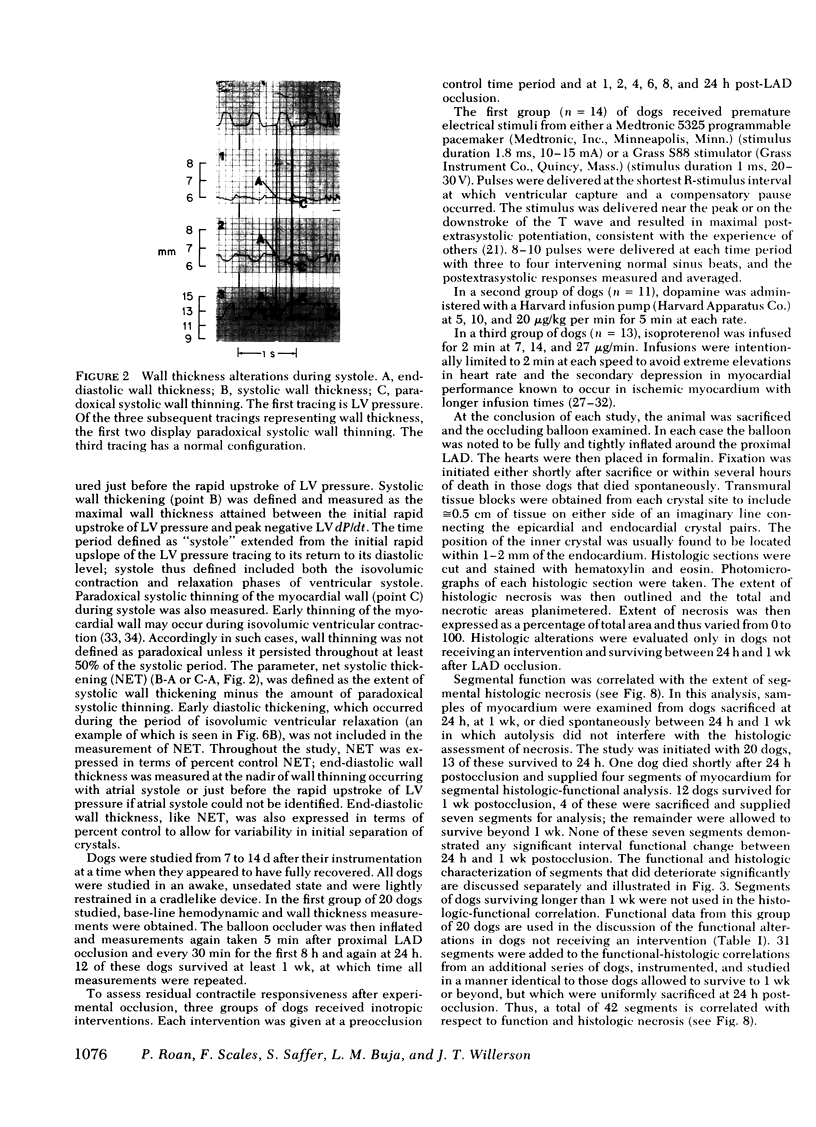
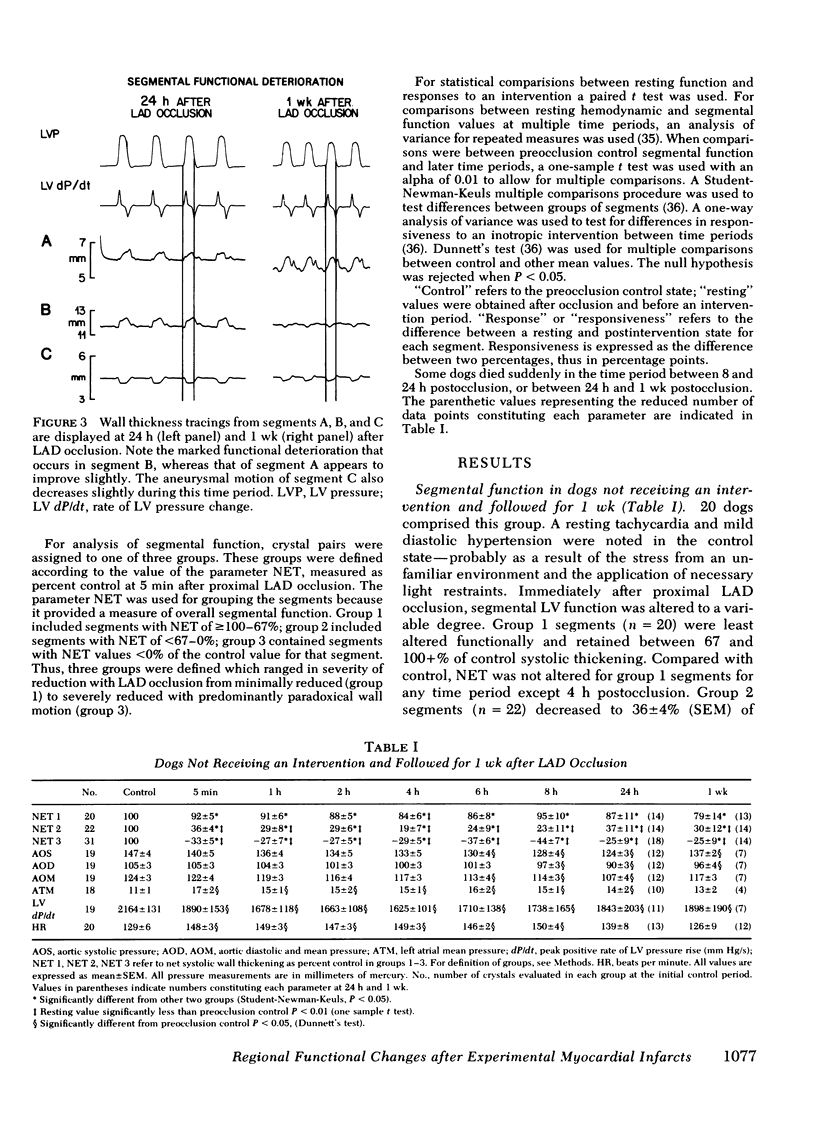
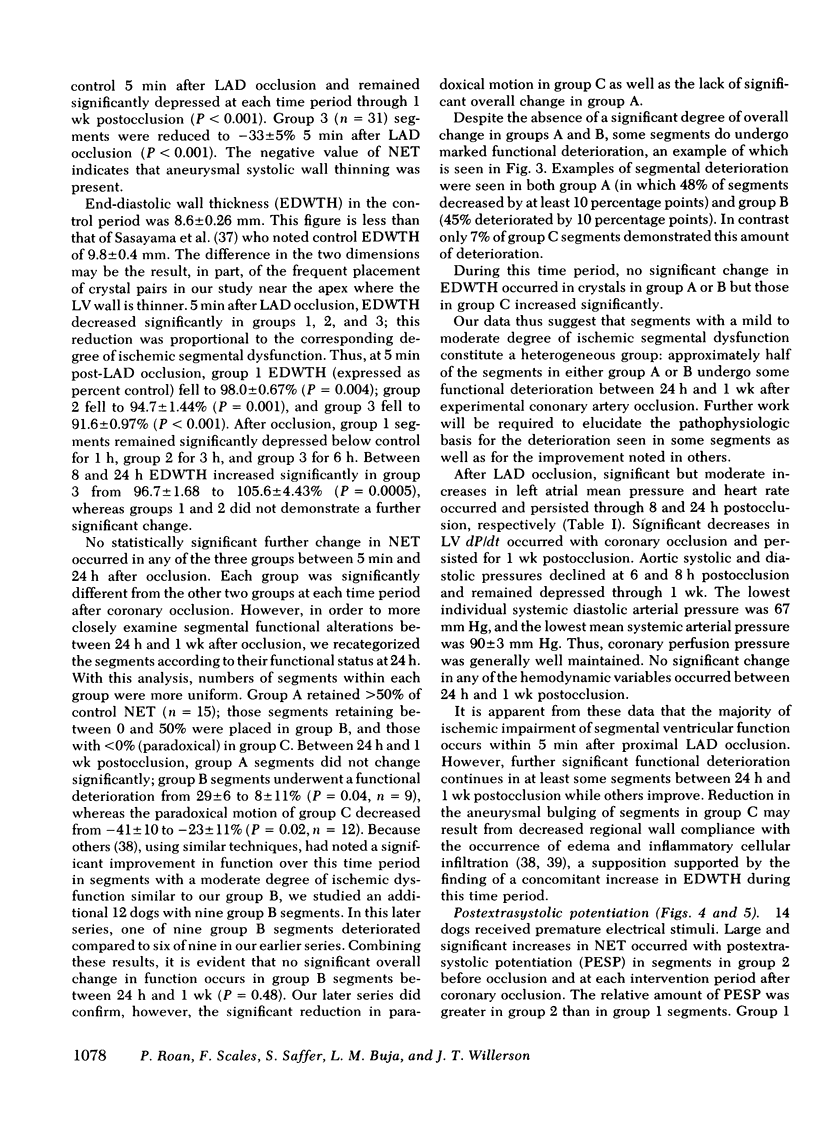
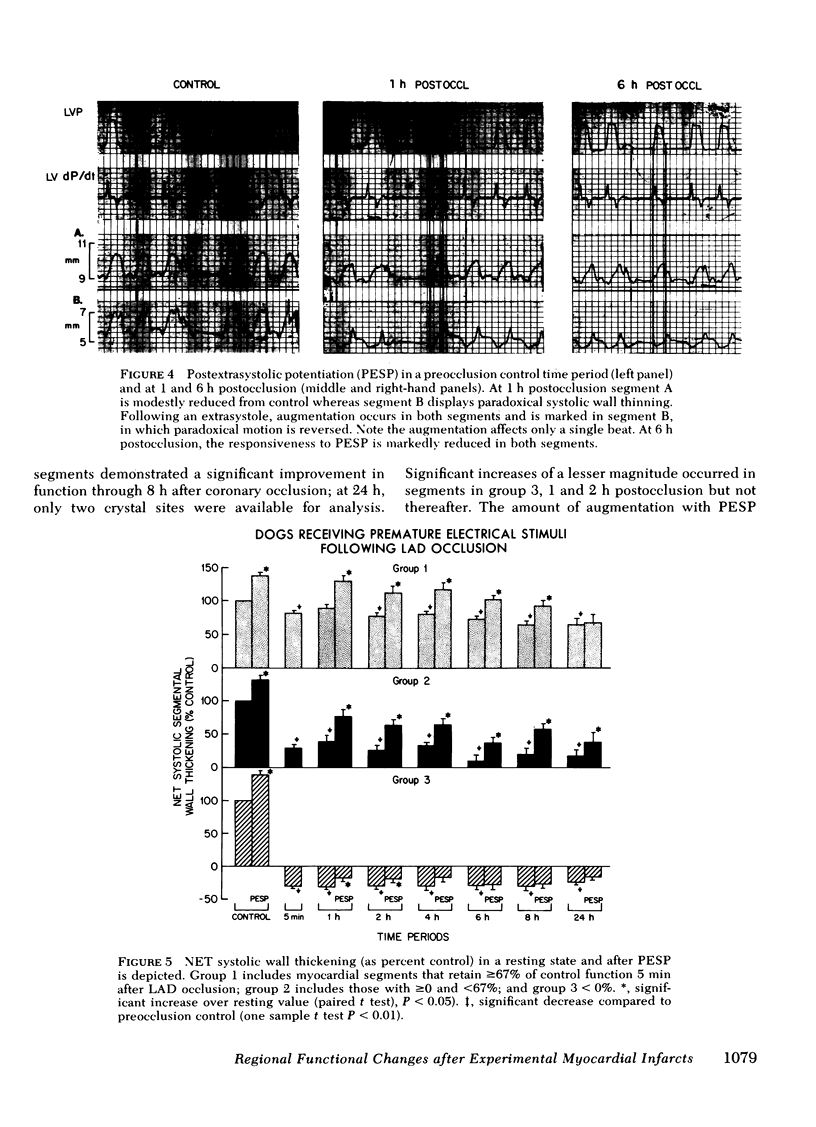
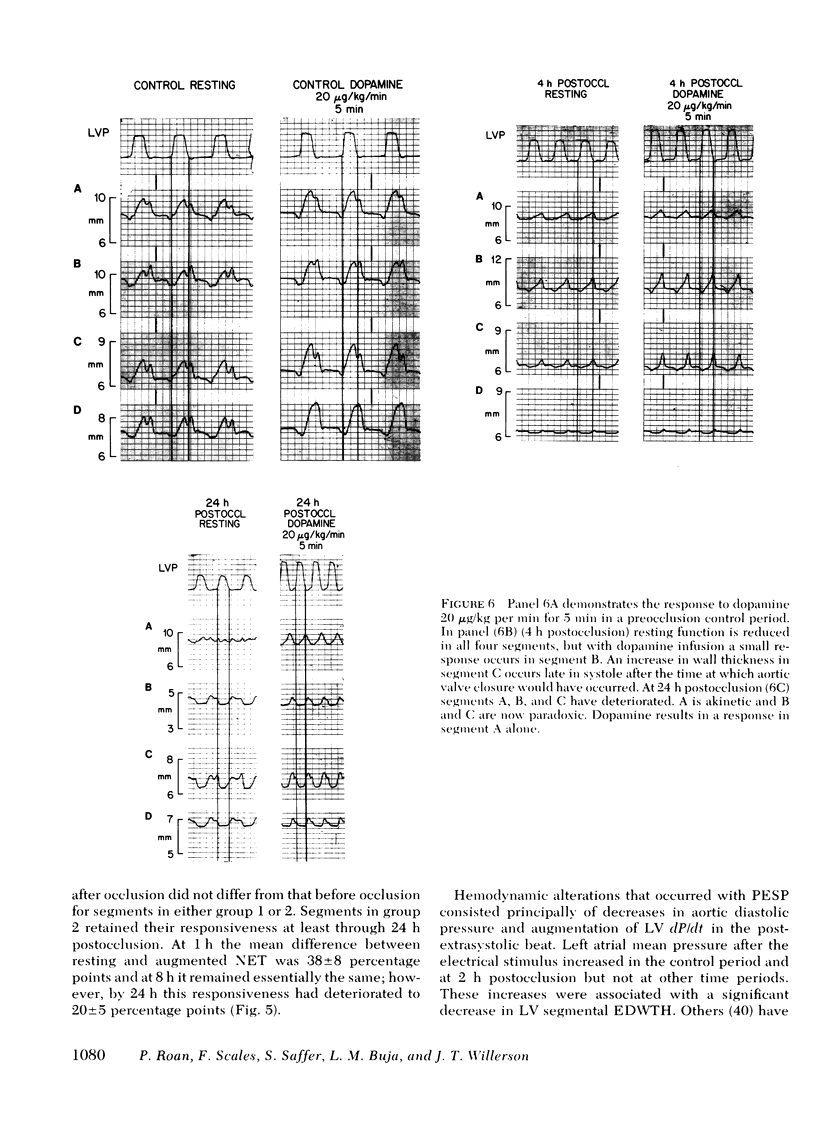
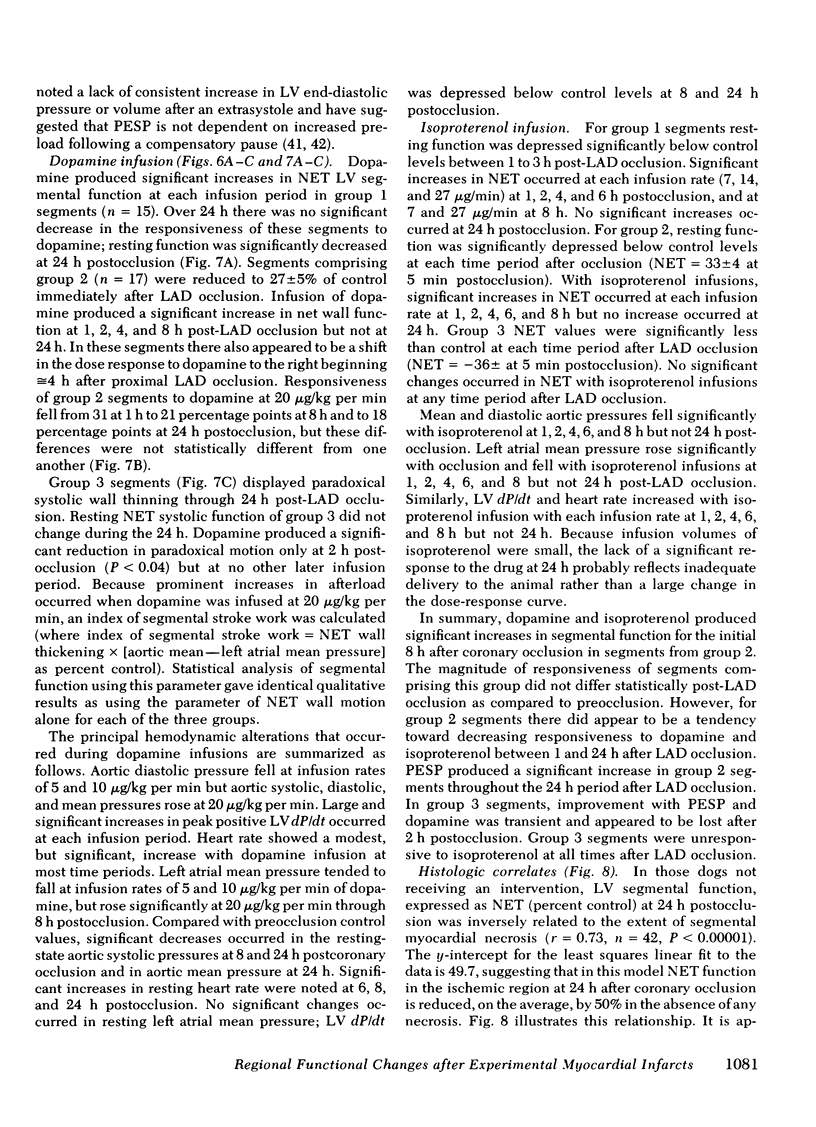
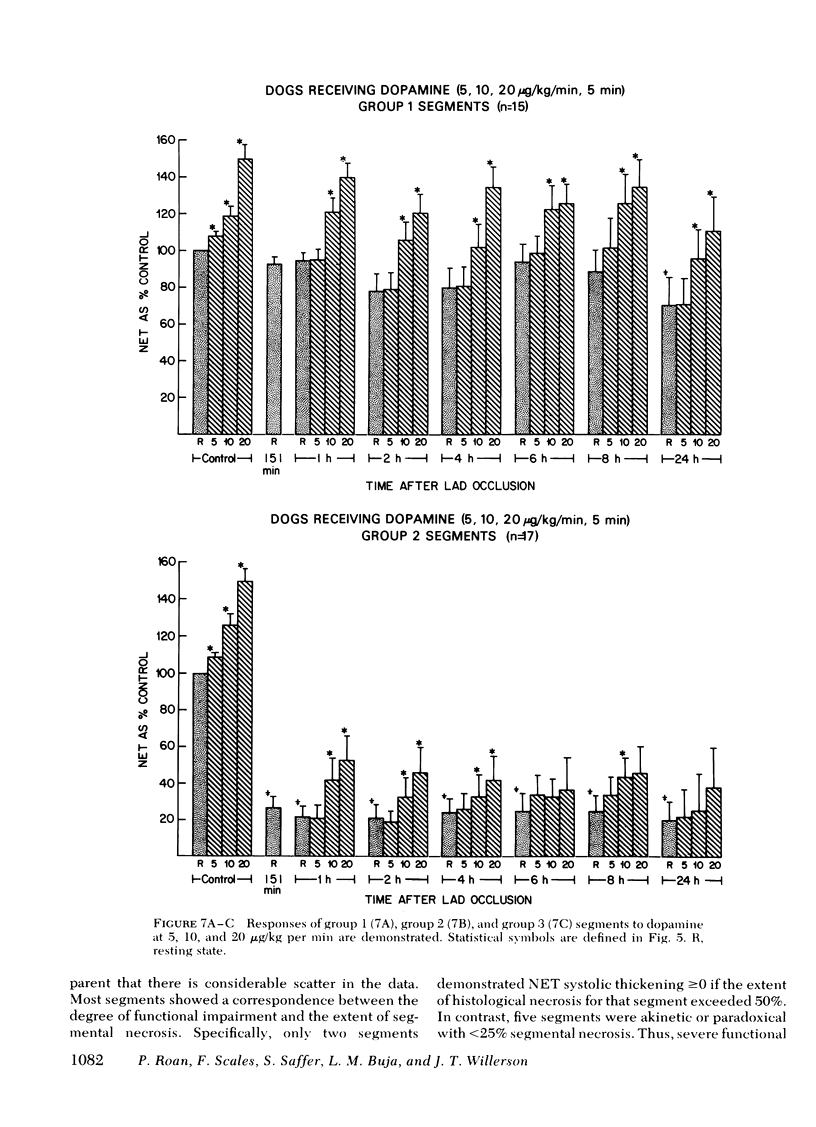
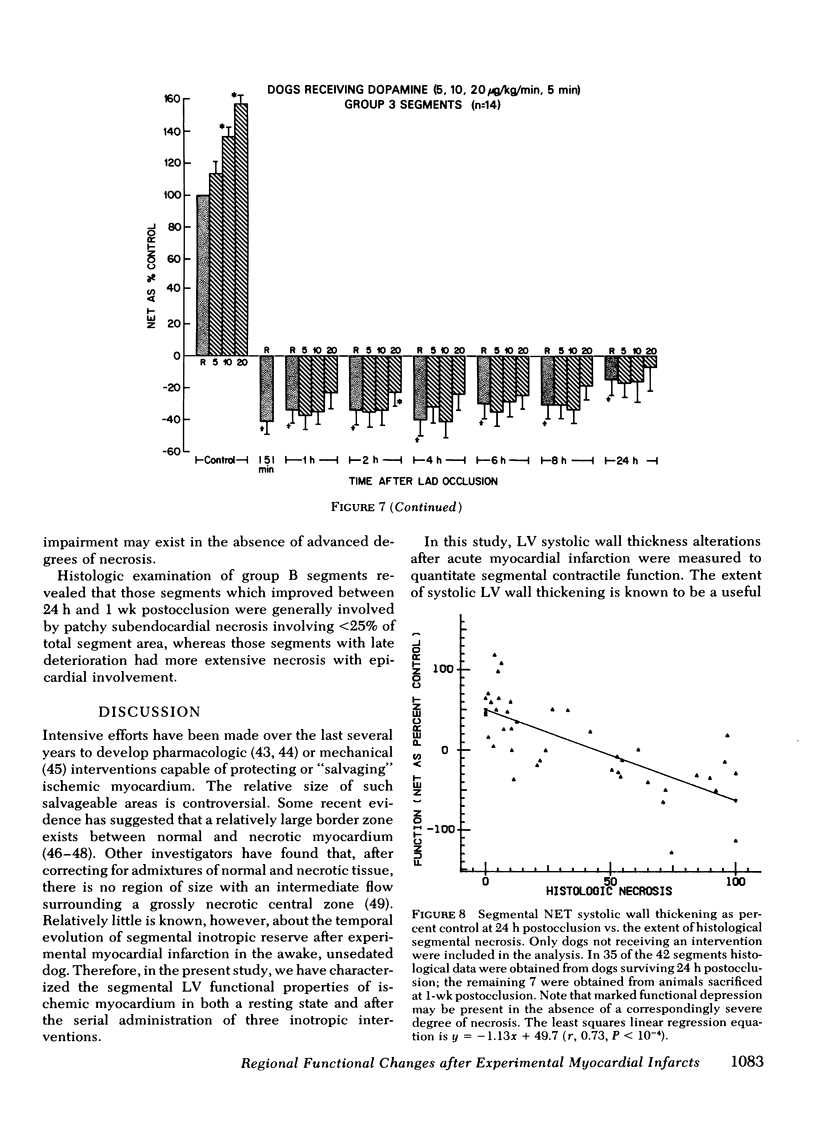
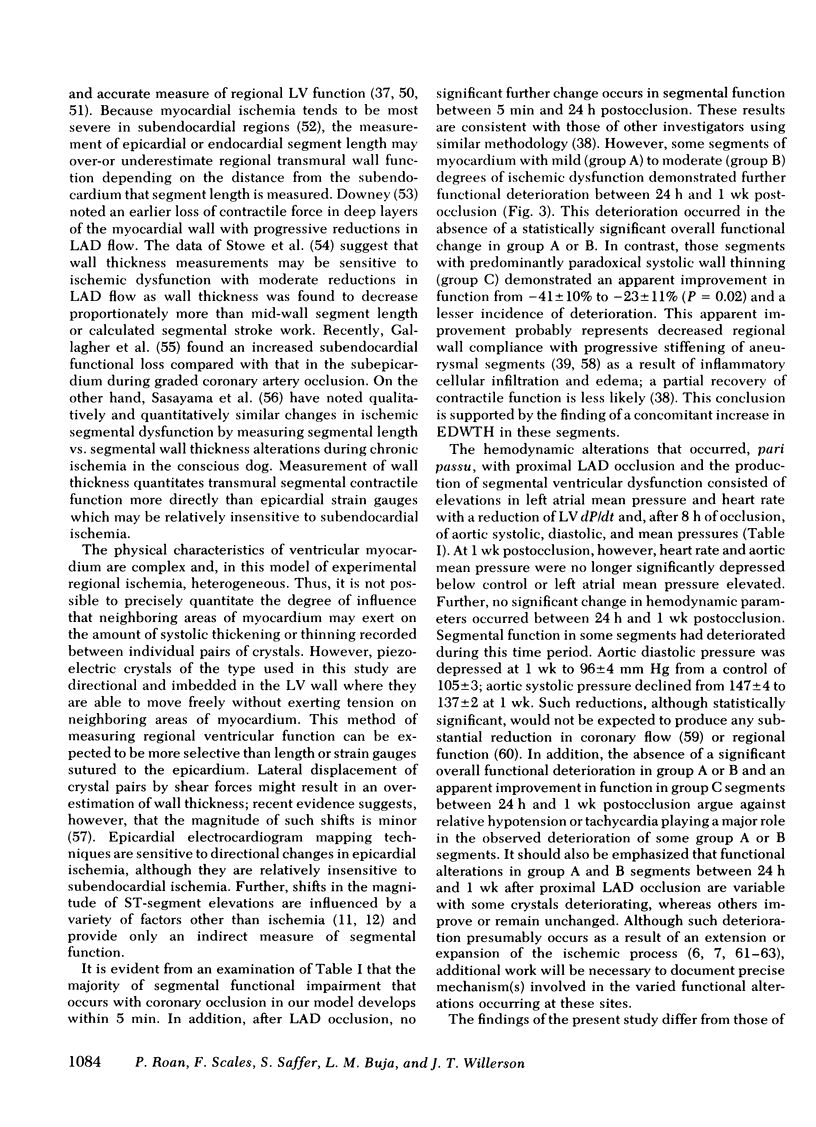
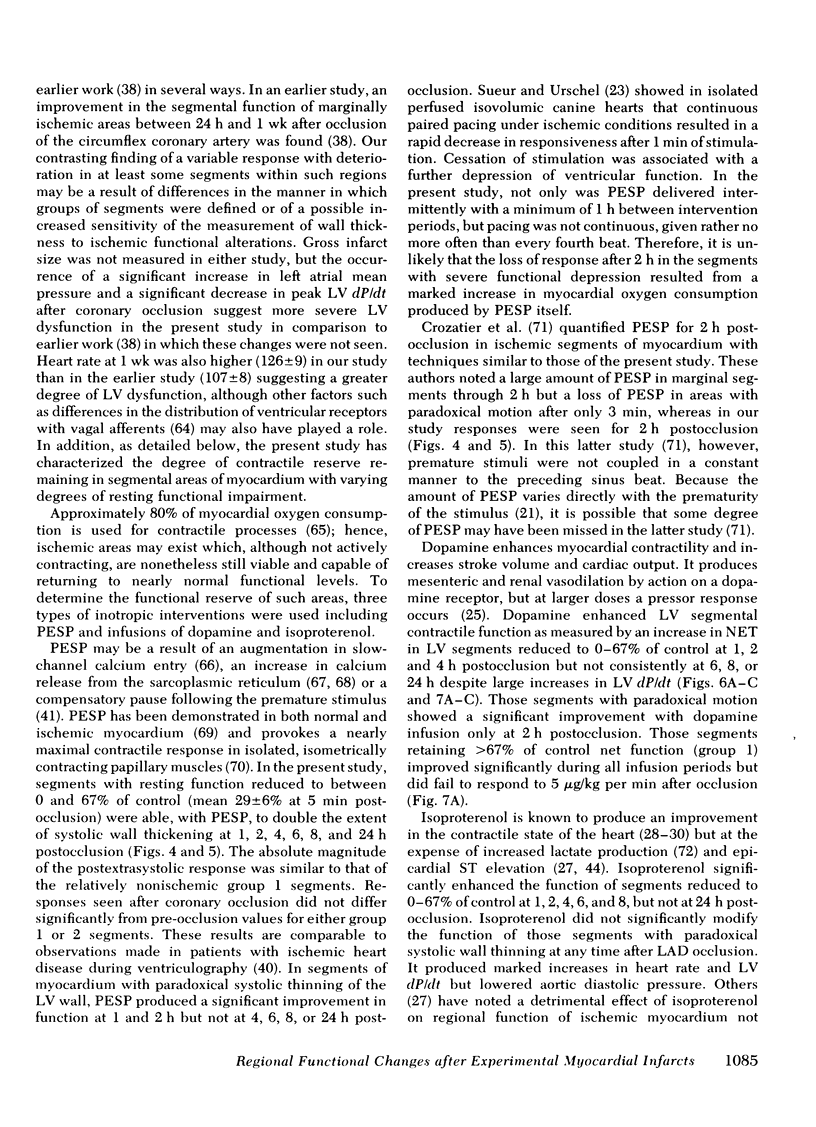
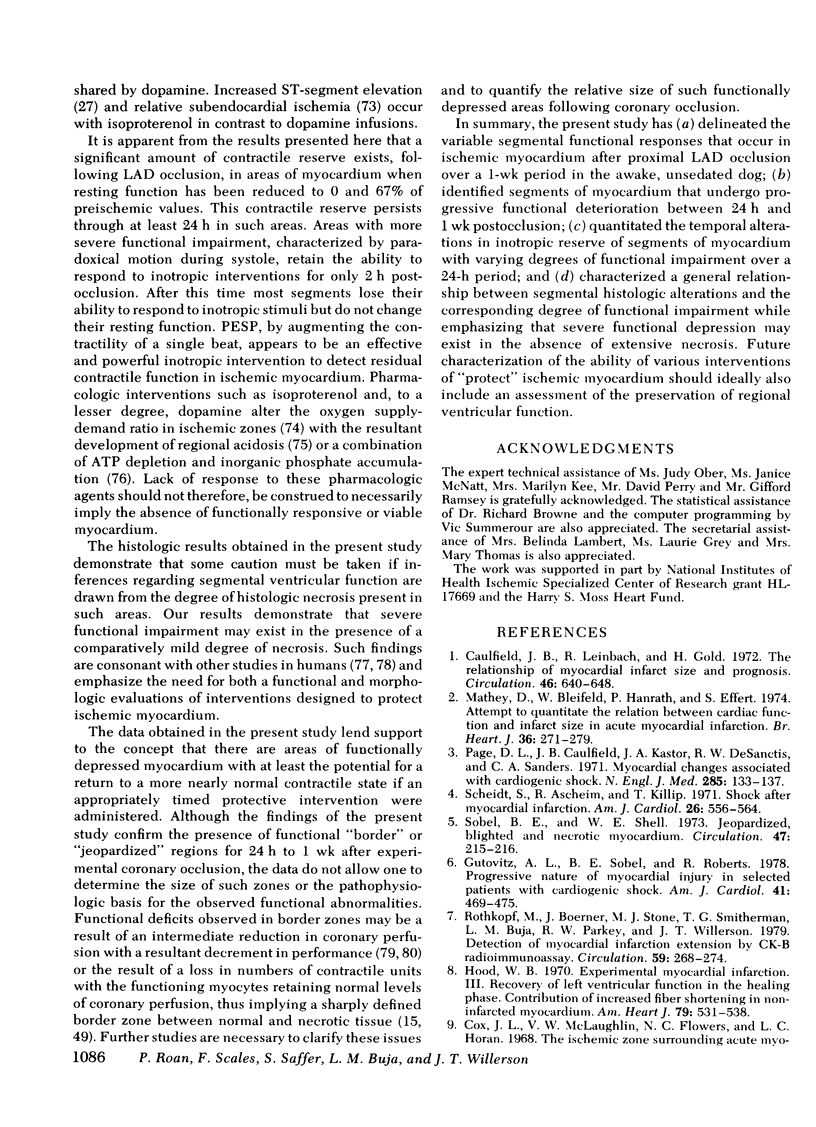
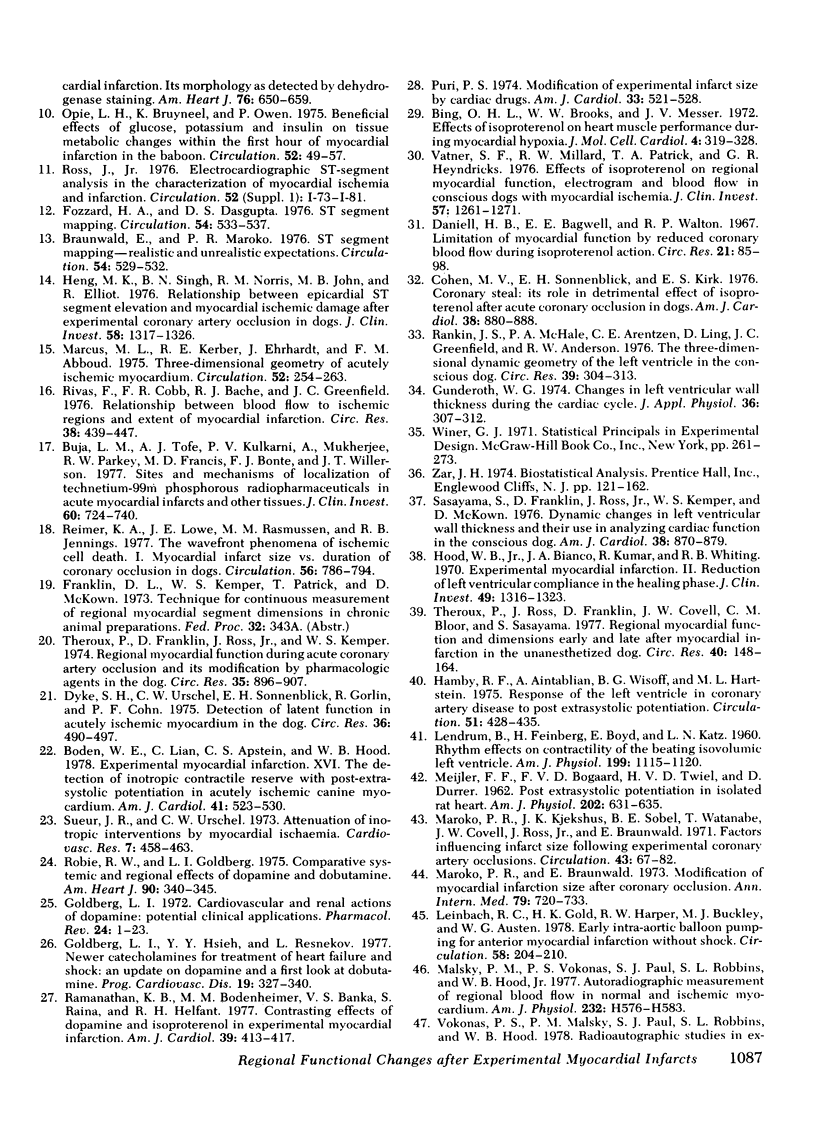
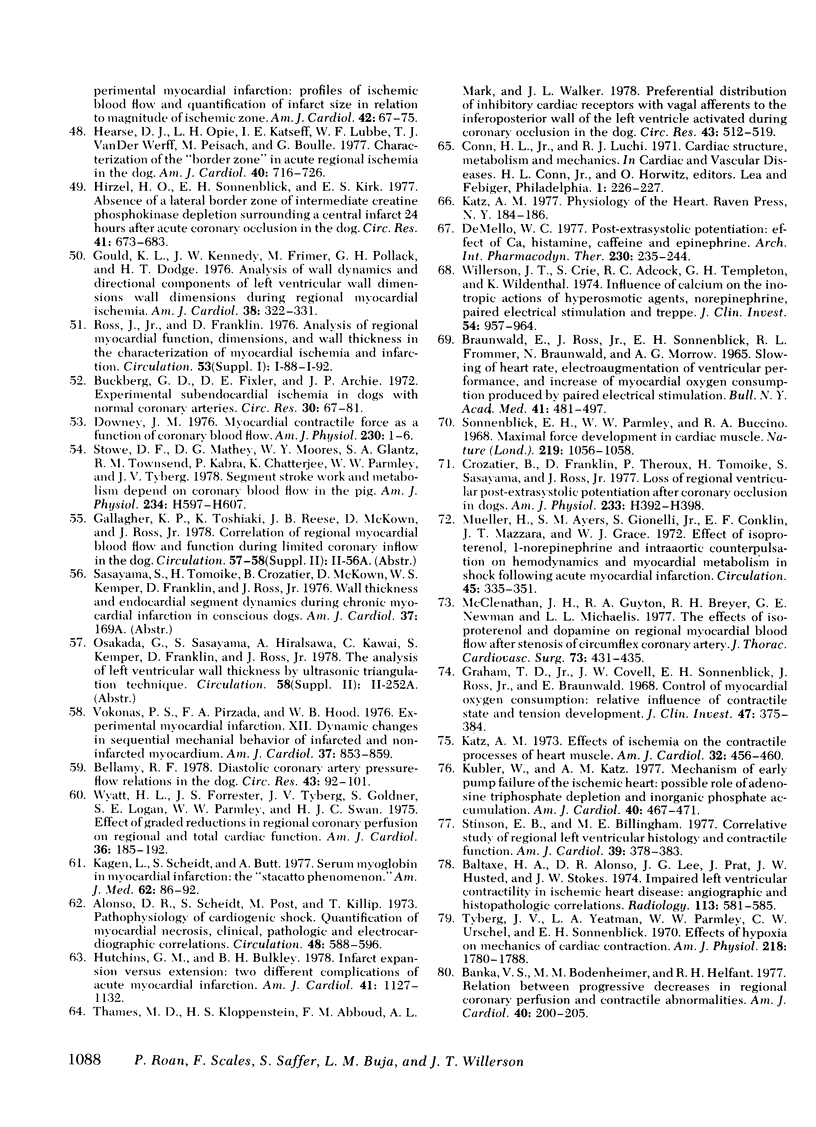
Selected References
These references are in PubMed. This may not be the complete list of references from this article.
- Alonso D. R., Scheidt S., Post M., Killip T. Pathophysiology of cardiogenic shock. Quantification of myocardial necrosis, clinical, pathologic and electrocardiographic correlations. Circulation. 1973 Sep;48(3):588–596. doi: 10.1161/01.cir.48.3.588. [DOI] [PubMed] [Google Scholar]
- BRAUNWALD E., ROSS J., Jr, SONNENBLICK E. H., FROMMER P. L., BRAUNWALD N. S., MORROW A. G. SLOWING OF HEART RATE, ELECTROAUGMENTATION OF VENTRICULAR PERFORMANCE, AND INCREASE OF MYOCARDIAL OXYGEN CONSUMPTION PRODUCED BY PAIRED ELECTRICAL STIMULATION. Bull N Y Acad Med. 1965 May;41:481–497. [PMC free article] [PubMed] [Google Scholar]
- Baltaxe H. A., Alonso D. R., Lee J. G., Prat J., Husted J. W., Stakes J. W., 3rd Impaired left ventricular contracility in ischemic heart disease: angiographic and histopathologic correlations. Radiology. 1974 Dec;113(3):581–585. doi: 10.1148/113.3.581. [DOI] [PubMed] [Google Scholar]
- Banka V. S., Bodenheimer M. M., Helfant R. H. Relation between progressive decreases in regional coronary perfusion and contractile abnormalities. Am J Cardiol. 1977 Aug;40(2):200–205. doi: 10.1016/0002-9149(77)90009-1. [DOI] [PubMed] [Google Scholar]
- Bellamy R. F. Diastolic coronary artery pressure-flow relations in the dog. Circ Res. 1978 Jul;43(1):92–101. doi: 10.1161/01.res.43.1.92. [DOI] [PubMed] [Google Scholar]
- Bing O. H., Brooks W. W., Messer J. V. Effects of isoproterenol on heart muscle performance during myocardial hypoxia. J Mol Cell Cardiol. 1972 Aug;4(4):319–328. doi: 10.1016/0022-2828(72)90078-8. [DOI] [PubMed] [Google Scholar]
- Boden W. E., Liang C. S., Apstein C. S., Hood W. B., Jr Experimental myocardial infarction. XVI. The detection of inotropic contractile reserve with postextrasystolic potentiation in acutely ischemic canine myocardium. Am J Cardiol. 1978 Mar;41(3):523–530. doi: 10.1016/0002-9149(78)90010-3. [DOI] [PubMed] [Google Scholar]
- Braunwald E., Maroko P. R. ST-segment mapping. Realistic and unrealistic expectations. Circulation. 1976 Oct;54(4):529–532. doi: 10.1161/01.cir.54.4.529. [DOI] [PubMed] [Google Scholar]
- Buckberg G. D., Fixler D. E., Archie J. P., Hoffman J. I. Experimental subendocardial ischemia in dogs with normal coronary arteries. Circ Res. 1972 Jan;30(1):67–81. doi: 10.1161/01.res.30.1.67. [DOI] [PubMed] [Google Scholar]
- Buja L. M., Tofe A. J., Kulkarni P. V., Mukherjee A., Parkey R. W., Francis M. D., Bonte F. J., Willerson J. T. Sites and mechanisms of localization of technetium-99m phosphorus radiopharmaceuticals in acute myocardial infarcts and other tissues. J Clin Invest. 1977 Sep;60(3):724–740. doi: 10.1172/JCI108825. [DOI] [PMC free article] [PubMed] [Google Scholar]
- Cohen M. V., Sonnenblick E. H., Kirk E. S. Coronary steal: its role in detrimental effect of isoproterenol after acute coronary occlusion in dogs. Am J Cardiol. 1976 Dec;38(7):880–888. doi: 10.1016/0002-9149(76)90801-8. [DOI] [PubMed] [Google Scholar]
- Cox J. L., McLaughlin V. W., Flowers N. C., Horan L. G. The ischemic zone surrounding acute myocardial infarction. Its morphology as detected by dehydrogenase staining. Am Heart J. 1968 Nov;76(5):650–659. doi: 10.1016/0002-8703(68)90164-6. [DOI] [PubMed] [Google Scholar]
- Crozatier B., Franklin D., Theroux P., Tomoike H., Sasayama S., Ross J., Jr Loss of regional ventricular postextrasystolic potentiation after coronary occlusion in dogs. Am J Physiol. 1977 Sep;233(3):H392–H348. doi: 10.1152/ajpheart.1977.233.3.H392. [DOI] [PubMed] [Google Scholar]
- Daniell H. B., Bagwell E. E., Walton R. P. Limitation of myocardial function by reduced coronary blood flow during isoproterenol action. Circ Res. 1967 Jul;21(1):85–98. doi: 10.1161/01.res.21.1.85. [DOI] [PubMed] [Google Scholar]
- Dyke S. H., Urschel C. W., Sonnenblick E. H., Gorlin R., Cohn P. F. Detection of latent function in acutely ischemic myocardium in the dog: comparison of pharmacologic inotropic stimulation and postextrasystolic potentiation. Circ Res. 1975 Apr;36(4):490–497. doi: 10.1161/01.res.36.4.490. [DOI] [PubMed] [Google Scholar]
- Fozzard H. A., DasGupta D. S. ST-segment potentials and mapping. Theory and experiments. Circulation. 1976 Oct;54(4):533–537. doi: 10.1161/01.cir.54.4.533. [DOI] [PubMed] [Google Scholar]
- Goldberg L. I. Cardiovascular and renal actions of dopamine: potential clinical applications. Pharmacol Rev. 1972 Mar;24(1):1–29. [PubMed] [Google Scholar]
- Goldberg L. I., Hsieh Y. Y., Resnekov L. Newer catecholamines for treatment of heart failure and shock: an update on dopamine and a first look at dobutamine. Prog Cardiovasc Dis. 1977 Jan-Feb;19(4):327–340. doi: 10.1016/0033-0620(77)90007-x. [DOI] [PubMed] [Google Scholar]
- Gould K. L., Kennedy J. W., Frimer M., Pollack G. H., Dodge H. T. Analysis of wall dynamics and directional components of left ventricular contraction in man. Am J Cardiol. 1976 Sep;38(3):322–331. doi: 10.1016/0002-9149(76)90174-0. [DOI] [PubMed] [Google Scholar]
- Graham T. P., Jr, Covell J. W., Sonnenblick E. H., Ross J., Jr, Braunwald E. Control of myocardial oxygen consumption: relative influence of contractile state and tension development. J Clin Invest. 1968 Feb;47(2):375–385. doi: 10.1172/JCI105734. [DOI] [PMC free article] [PubMed] [Google Scholar]
- Gutovitz A. L., Sobel B. E., Roberts R. Progressive nature of myocardial injury in selected patients with cardiogenic shock. Am J Cardiol. 1978 Mar;41(3):469–475. doi: 10.1016/0002-9149(78)90001-2. [DOI] [PubMed] [Google Scholar]
- Hamby R. I., Aintablian A., Wisoff G., Hartstein M. L. Response of the left ventricle in coronary artery disease to postextrasystolic potentiation. Circulation. 1975 Mar;51(3):428–435. doi: 10.1161/01.cir.51.3.428. [DOI] [PubMed] [Google Scholar]
- Hearse J. D., Opie L. H., Katzeff I. E., Lubbe W. F., Van der Werff T. J., Peisach M., Boulle G. Characterization of the "border zone" in acute regional ischemia in the dog. Am J Cardiol. 1977 Nov;40(5):716–726. doi: 10.1016/0002-9149(77)90187-4. [DOI] [PubMed] [Google Scholar]
- Heng M. K., Singh B. N., Norris R. M., John M. B., Elliot R. Relationship between epicardial ST-segment elevation and myocardial ischemic damage after experimental coronary artery occlusion in dogs. J Clin Invest. 1976 Dec;58(6):1317–1326. doi: 10.1172/JCI108587. [DOI] [PMC free article] [PubMed] [Google Scholar]
- Hirzel H. O., Sonnenblick E. H., Kirk E. S. Absence of a lateral border zone of intermediate creatine phosphokinase depletion surrounding a central infarct 24 hours after acute coronary occlusion in the dog. Circ Res. 1977 Nov;41(5):673–683. doi: 10.1161/01.res.41.5.673. [DOI] [PubMed] [Google Scholar]
- Hood W. B., Jr, Bianco J. A., Kumar R., Whiting R. B. Experimental myocardial infarction. IV. Reduction of left ventricular compliance in the healing phase. J Clin Invest. 1970 Jul;49(7):1316–1323. doi: 10.1172/JCI106347. [DOI] [PMC free article] [PubMed] [Google Scholar]
- Hood W. B., Jr Experimental myocardial infarction. 3. Recovery of left ventricular function in the healing phase. Contribution of increased fiber shortening in noninfarcted myocardium. Am Heart J. 1970 Apr;79(4):531–538. doi: 10.1016/0002-8703(70)90259-0. [DOI] [PubMed] [Google Scholar]
- Katz A. M. Effects of ischemia on the contractile processes of heart muscle. Am J Cardiol. 1973 Sep 20;32(4):456–460. doi: 10.1016/s0002-9149(73)80036-0. [DOI] [PubMed] [Google Scholar]
- Kübler W., Katz A. M. Mechanism of early "pump" failure of the ischemic heart: possible role of adenosine triphosphate depletion and inorganic phosphate accumulation. Am J Cardiol. 1977 Sep;40(3):467–471. doi: 10.1016/0002-9149(77)90174-6. [DOI] [PubMed] [Google Scholar]
- LENDRUM B., FEINBERG H., BOYD E., KATZ L. N. Rhythm effects on contractility of the beating isovolumic left ventricle. Am J Physiol. 1960 Dec;199:1115–1120. doi: 10.1152/ajplegacy.1960.199.6.1115. [DOI] [PubMed] [Google Scholar]
- Leinbach R. C., Gold H. K., Harper R. W., Buckley M. J., Austen W. G. Early intraaortic balloon pumping for anterior myocardial infarction without shock. Circulation. 1978 Aug;58(2):204–210. doi: 10.1161/01.cir.58.2.204. [DOI] [PubMed] [Google Scholar]
- MEIJLER F. L., vd BOGAARD F., vd TWEELH D., DURRER Postextrasystolic potentiation in the isolated rat heart. Am J Physiol. 1962 Apr;202:631–635. doi: 10.1152/ajplegacy.1962.202.4.631. [DOI] [PubMed] [Google Scholar]
- Malsky P. M., Vokonas P. S., Paul S. J., Robbins S. L., Hood W. B., Jr Autoradiographic measurement of regional blood flow in normal and ischemic myocardium. Am J Physiol. 1977 Jun;232(6):H576–H583. doi: 10.1152/ajpheart.1977.232.6.H576. [DOI] [PubMed] [Google Scholar]
- Marcus M. L., Kerber R. E., Ehrhardt J., Abboud F. M. Three dimensional geometry of acutely ischemic myocardium. Circulation. 1975 Aug;52(2):254–263. doi: 10.1161/01.cir.52.2.254. [DOI] [PubMed] [Google Scholar]
- Maroko P. R., Braunwald E. Modification of myocardial infarction size after coronary occlusion. Ann Intern Med. 1973 Nov;79(5):720–733. doi: 10.7326/0003-4819-79-5-720. [DOI] [PubMed] [Google Scholar]
- Maroko P. R., Kjekshus J. K., Sobel B. E., Watanabe T., Covell J. W., Ross J., Jr, Braunwald E. Factors influencing infarct size following experimental coronary artery occlusions. Circulation. 1971 Jan;43(1):67–82. doi: 10.1161/01.cir.43.1.67. [DOI] [PubMed] [Google Scholar]
- Mathey D., Biefield W., Hanrath P., Effert S. Attempt to quantitate relation between cardiac function and infarct size in acute myocardial infarction. Br Heart J. 1974 Mar;36(3):271–279. doi: 10.1136/hrt.36.3.271. [DOI] [PMC free article] [PubMed] [Google Scholar]
- McClenathan J. H., Guyton R. A., Breyer R. H., Newman G. E., Michaelis L. L. The effects of isoproterenol and dopamine on regional myocardial blood flow after stenosis of circumflex coronary artery. J Thorac Cardiovasc Surg. 1977 Mar;73(3):431–435. [PubMed] [Google Scholar]
- Mueller H., Ayres S. M., Giannelli S., Jr, Conklin E. F., Mazzara J. T., Grace W. J. Effect of isoproterenol,l-norepinephrine, and intraaortic counterpulsation on hemodynamics and myocardial metabolism in shock following acute myocardial infarction. Circulation. 1972 Feb;45(2):335–351. doi: 10.1161/01.cir.45.2.335. [DOI] [PubMed] [Google Scholar]
- Opie L. H., Bruyneel K., Owen P. Effects of glucose, insulin and potassium infusion on tissue metabolic changes within first hour of myocardial infarction in the baboon. Circulation. 1975 Jul;52(1):49–57. doi: 10.1161/01.cir.52.1.49. [DOI] [PubMed] [Google Scholar]
- Page D. L., Caulfield J. B., Kastor J. A., DeSanctis R. W., Sanders C. A. Myocardial changes associated with cardiogenic shock. N Engl J Med. 1971 Jul 15;285(3):133–137. doi: 10.1056/NEJM197107152850301. [DOI] [PubMed] [Google Scholar]
- Puri P. S. Modification of experimental myocardial infarct size by cardiac drugs. Am J Cardiol. 1974 Apr;33(4):521–528. doi: 10.1016/0002-9149(74)90612-2. [DOI] [PubMed] [Google Scholar]
- Ramanathan K. B., Bodenheimer M. M., Banka V. S., Raina S., Helfant R. H. Contrasting effects of dopamine and isoproterenol in experimental myocardial infarction. Am J Cardiol. 1977 Mar;39(3):413–417. doi: 10.1016/s0002-9149(77)80098-2. [DOI] [PubMed] [Google Scholar]
- Rankin J. S., McHale P. A., Arentzen C. E., Ling D., Greenfield J. C., Jr, Anderson R. W. The three-dimensional dynamic geometry of the left ventricle in the conscious dog. Circ Res. 1976 Sep;39(3):304–313. doi: 10.1161/01.res.39.3.304. [DOI] [PubMed] [Google Scholar]
- Reimer K. A., Lowe J. E., Rasmussen M. M., Jennings R. B. The wavefront phenomenon of ischemic cell death. 1. Myocardial infarct size vs duration of coronary occlusion in dogs. Circulation. 1977 Nov;56(5):786–794. doi: 10.1161/01.cir.56.5.786. [DOI] [PubMed] [Google Scholar]
- Rivas F., Cobb F. R., Bache R. J., Greenfield J. C., Jr Relationship between blood flow to ischemic regions and extent of myocardial infarction. Serial measurement of blood flow to ischemic regions in dogs. Circ Res. 1976 May;38(5):439–447. doi: 10.1161/01.res.38.5.439. [DOI] [PubMed] [Google Scholar]
- Robie N. W., Goldberg L. I. Comparative systemic and regional hemodynamic effects of dopamine and dobutamine. Am Heart J. 1975 Sep;90(3):340–345. doi: 10.1016/0002-8703(75)90323-3. [DOI] [PubMed] [Google Scholar]
- Rothkopf M., Boerner J., Stone M. J., Smitherman T. C., Buja L. M., Parkey R. W., Willerson J. T. Detection of myocardial infarct extension by CK-B radioimmunoassay. Circulation. 1979 Feb;59(2):268–274. doi: 10.1161/01.cir.59.2.268. [DOI] [PubMed] [Google Scholar]
- Sasayama S., Franklin D., Ross J., Jr, Kemper W. S., McKown D. Dynamic changes in left ventricular wall thickness and their use in analyzing cardiac function in the conscious dog. Am J Cardiol. 1976 Dec;38(7):870–879. doi: 10.1016/0002-9149(76)90800-6. [DOI] [PubMed] [Google Scholar]
- Scheidt S., Ascheim R., Killip T., 3rd Shock after acute myocardial infarction. A clinical and hemodynamic profile. Am J Cardiol. 1970 Dec;26(6):556–564. doi: 10.1016/0002-9149(70)90407-8. [DOI] [PubMed] [Google Scholar]
- Serur J. R., Urschel C. W. Attenuation of inotropic interventions by myocardial ischaemia. Cardiovasc Res. 1973 Jul;7(4):458–463. doi: 10.1093/cvr/7.4.458. [DOI] [PubMed] [Google Scholar]
- Sobel B. E., Bresnahan G. F., Shell W. E., Yoder R. D. Estimation of infarct size in man and its relation to prognosis. Circulation. 1972 Oct;46(4):640–648. doi: 10.1161/01.cir.46.4.640. [DOI] [PubMed] [Google Scholar]
- Sobel B. E., Shell W. E. Jeopardized, blighted, and necrotic myocardium. Circulation. 1973 Feb;47(2):215–216. doi: 10.1161/01.cir.47.2.215. [DOI] [PubMed] [Google Scholar]
- Stinson E. B., Billingham M. E. Correlative study of regional left ventricular histology and contractile function. Am J Cardiol. 1977 Mar;39(3):378–383. doi: 10.1016/s0002-9149(77)80092-1. [DOI] [PubMed] [Google Scholar]
- Stowe D. F., Mathey D. G., Moores W. Y., Glantz S. A., Townsend R. M., Kabra P., Chatterjee K., Parmley W. W., Tyberg J. V. Segment stroke work and metabolism depend on coronary blood flow in the pig. Am J Physiol. 1978 May;234(5):H597–H607. doi: 10.1152/ajpheart.1978.234.5.H597. [DOI] [PubMed] [Google Scholar]
- Thames M. D., Klopfenstein H. S., Abboud F. M., Mark A. L., Walker J. L. Preferential distribution of inhibitory cardiac receptors with vagal afferents to the inferoposterior wall of the left ventricle activated during coronary occlusion in the dog. Circ Res. 1978 Oct;43(4):512–519. doi: 10.1161/01.res.43.4.512. [DOI] [PubMed] [Google Scholar]
- Theroux P., Franklin D., Ross J., Jr, Kemper W. S. Regional myocardial function during acute coronary artery occlusion and its modification by pharmacologic agents in the dog. Circ Res. 1974 Dec;35(6):896–908. doi: 10.1161/01.res.35.6.896. [DOI] [PubMed] [Google Scholar]
- Tyberg J. V., Yeatman L. A., Parmley W. W., Urschel C. W., Sonnenblick E. H. Effects of hypoxia on mechanics of cardiac contraction. Am J Physiol. 1970 Jun;218(6):1780–1788. doi: 10.1152/ajplegacy.1970.218.6.1780. [DOI] [PubMed] [Google Scholar]
- Vatner S. F., Millard R. W., Patrick T. A., Heyndrickx G. R. Effects of isoproterenol on regional myocardial function, electrogram, and blood flow in conscious dogs with myocardial ischemia. J Clin Invest. 1976 May;57(5):1261–1271. doi: 10.1172/JCI108394. [DOI] [PMC free article] [PubMed] [Google Scholar]
- Vokonas P. S., Pirzada F., Hood W. B., Jr Experimental myocardial infarction: XII. Dynamic changes in segmental mechanical behavior of infarcted and non-infarcted myocardium. Am J Cardiol. 1976 May;37(6):853–859. doi: 10.1016/0002-9149(76)90109-0. [DOI] [PubMed] [Google Scholar]
- Willerson J. T., Crie J. S., Adcock R. C., Templeton G. H., Wildenthal K. Influence of calcium on the inotropic actions of hyperosmotic agents, norepinephrine, paired electrical stimulation, and treppe. J Clin Invest. 1974 Oct;54(4):957–964. doi: 10.1172/JCI107836. [DOI] [PMC free article] [PubMed] [Google Scholar]
- Wyatt H. L., Forrester J. S., Tyberg J. V., Goldner S., Logan S. E., Parmley W. W., Swan H. J. Effect of graded reductions in regional coronary perfusion on regional and total cardiac function. Am J Cardiol. 1975 Aug;36(2):185–192. doi: 10.1016/0002-9149(75)90524-x. [DOI] [PubMed] [Google Scholar]


